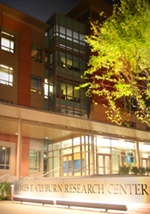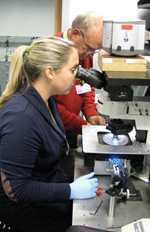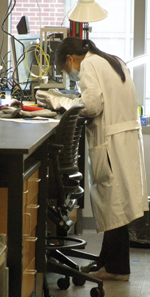|
 A
veteran benefits from a
treatment that regenerates brain
tissue from his own cells that
allows his brain to repair
itself. A baby with an irregular
heart rhythm receives bionic
pacemaker cells, cultured from
her own body, that allow her
heart to settle into a normal
rhythm so that she won't need
medications or devices to live a
normal life. A breast cancer
survivor goes to her oncologist
who uses fluoroscopic images to
track down any remaining tumors
she might have. A
veteran benefits from a
treatment that regenerates brain
tissue from his own cells that
allows his brain to repair
itself. A baby with an irregular
heart rhythm receives bionic
pacemaker cells, cultured from
her own body, that allow her
heart to settle into a normal
rhythm so that she won't need
medications or devices to live a
normal life. A breast cancer
survivor goes to her oncologist
who uses fluoroscopic images to
track down any remaining tumors
she might have.
If you think
these three stories sound like
science fiction, you're only half
right.
They're based
on just a few of the scientific
advances that are rapidly evolving
toward useful therapeutic
practices thanks to the
collaborative work of
bioengineering teams in the
Clyburn Research Center.
Supporting
researchers from Clemson
University, the University of
South Carolina and MUSC, the
Bioengineering Building has the
potential to become one of the
nation's most productive centers
for the development of
biologically useful materials,
devices and systems, guiding the
process from discovery to
practical solutions for some of
the most pressing health concerns.
"Bioengineering
applies principles and methods
from the physical and engineering
sciences to the life sciences to
enable understanding of disease
processes and to improve medical
care," said Richard Swaja, Ph.D.,
director of the South Carolina
Bioengineering Alliance.
"Our labs use
concepts from physics, chemistry,
computer science, mechanical and
electrical engineering, cellular
and molecular biology and other
fields to create practical ways to
regenerate body tissues, correct
problems before symptoms are
observed and make diagnostic
technologies more efficient."
Bioengineering
brings together different
scientific disciplines to provide
collaborative approaches for
addressing problems in biology and
medicine. Research teams typically
include members with widely
different areas of expertise —
practicing clinicians,
biomaterials specialists,
chemists, computer scientists and
geneticists. They study health
problems that defy single
disciplinary solutions, and they
use their combined power to find
and test novel approaches that
cross scientific boundaries.
 Sarah Haviland,
Ph.D.(c), and Dr. Lars Cleemann
work in the lab of Dr. Martin
Morad. Sarah Haviland,
Ph.D.(c), and Dr. Lars Cleemann
work in the lab of Dr. Martin
Morad.
"By working
across disciplines, we can develop
technologies that are not only
unique but also have broader
impact than initially considered,"
explained Swaja. "For example,
while we were testing a method to
locate cancer cells, we discovered
that the technique could also be
used to destroy them."
Leading several
of these applied-research efforts
in the Bioengineering Building is
Xuejun Wen, M.D., Ph.D., Hansjörg
Wyss Endowed Chair Professor, who
holds faculty appointments at both
Clemson and MUSC. After being
recruited to Clemson in 2003 from
the University of Utah in Salt
Lake City, Wen assembled research
teams that are pursuing dozens of
different clinical uses for
bioengineered materials, ranging
from gels that re-grow tissues
inside the body to bioreactors
that allow researchers to
streamline their studies by
culturing hard-to-grow cells in
the laboratory.
"Our labs have
bioengineers and graduate students
from Clemson working alongside
basic scientists and clinicians
from MUSC," he said. "That
cross-fertilization is what helps
compress the discovery timeline
and moves us toward practical
applications for our
technologies."
This targeted
approach has led to ongoing
projects to fight diabetes,
skeletal degeneration, pulmonary
problems and neural pathologies
stemming from acute injury or
chronic progressions like
Parkinson's disease and
Alzheimer's disease.
Promising areas
his team will explore include:
The development of a variety of
biocompatible polymers — materials
with biomechanical and biochemical
properties to support cell-growth
and appropriate differentiation
that can be used by researchers
here and elsewhere to explore new
modes of tissue engineering to
counter organ and tissue damage.
The engineering of biocompatible
hydrogels that mimic specific body
tissues to form a foundation for
different tissue regeneration.
The use of
nanoparticles — a million of them
could rest on the head of a pin —
that can be tagged with bioactive
molecules to glow in the presence
of fluoroscopy so they can do such
tasks as pinpointing malignant
cells and possibly eliminating
them.
To choose the
most worthwhile avenues for
research projects, Wen and his
colleagues put each new idea to a
simple test. Drawing on their
combined expertise in engineering
and medical science, they evaluate
each project by asking two
questions.
"The first
thing we ask ourselves is if our
idea is different. If our research
tells us it is, then we ask, 'Is
it better than what's available
now?'" said Wen.
Teaching the
heart to beat
Using modified cells to study and
correct cardiac problems is the
focus of another bioengineering
researcher at the Clyburn center,
Martin Morad, Ph.D., BlueCross
BlueShield of South Carolina
Foundation Endowed Chair in
Cardiovascular Health. He directs
the work of teams in his Cardiac
Signaling Center, a group
collaborating with scientists from
MUSC's other high-profile cardiac
research efforts to develop new
therapies that address heart
problems involving electrical,
rhythmic and muscular
disturbances.
"Rhythm
problems are very common and
sometimes life-threatening," he
said. "Implantable pacemakers have
been used for generations to make
damaged hearts function more
efficiently, but that means living
with wires, batteries, uncertainty
— things that can make life
difficult. A big part of our
research is doing roughly the same
thing, but on a cellular level
that delivers a life-long fix."
Instead of
implanting a device that paces the
heart with electrical pulses, his
researchers are working to correct
the heart's own signaling network.
It all starts with adult stem
cells, the most basic part of the
body's system for repairing and
replacing aged or damaged tissues.
After harvesting cells from the
patient's bone marrow and other
sources, Morad's molecular biology
teams induce them to take on new
functions or characteristics,
including training them to become
functioning heart cells.
"You can
actually see the ones that become
cardiac cells because they start
to beat," said Morad. "When you
combine them, they teach
themselves to beat in unison. We
see them do the same thing when
they come in contact with cells in
the heart muscle."
 Van Tran, Ph.D.(c),
right, does research in Dr.
Xuejun Wen's stem cell
laboratory in the Bioengineering
Building. Van Tran, Ph.D.(c),
right, does research in Dr.
Xuejun Wen's stem cell
laboratory in the Bioengineering
Building.
Since the
cardiac cells are developed from a
patient's own cells, they can be
introduced into the heart without
the kind of rejection problems
seen in cellular transplants from
other sources. Experimental models
have already shown that this
technique can correct rhythm
disturbances that cause the heart
muscle to beat irregularly or too
weakly.
As dramatic as the discoveries may
seem, the therapeutic benefits may
be just the tip of a research
iceberg. Creating viable cardiac
cells for study outside the body
may prove even more useful in
efforts to understand how
signaling mechanisms within cells
go wrong — and how they can be
modified to improve cardiac
functioning in patients from
infants to adults.
Fostering
Partnerships
Frank Treiber, Ph.D., South
Carolina SmartState Endowed
Research Chair, said he's excited
to see how the Clyburn Research
Center will impact the state's
latest Center of Economic
Excellence, the Technology
Applications Center for Healthful
Lifestyles (TACHL).
The TACHL, a
partnership involving MUSC, the
University of South Carolina and
Clemson, will develop, evaluate
and commercialize technology for
individuals, worksites, community
groups and health care provider
networks. The goal is to foster
disease prevention and health care
management.
A recent
collaboration involving MUSC,
Clemson and a local software
application company, Reaction
Apps, resulted in a smart
phone-delivered stress reduction
program. This program includes
real time monitoring of heart rate
with immediate feedback charts
following each meditation session
and motivational messages to help
sustain the practice over time.
Products will
include software and information
systems for mobile smart phones,
iPad tablet technologies and other
methods, all of which will help
implement lifestyle programs and
medical regimens, and monitor
related behavioral or biological
functions.
Another group
excited to have the bioengineering
teams nearby are fellow
researchers in MUSC's Center for
Rehabilitation Research in
Neurological Conditions within the
College of Health Professions. The
center's co-director, Steve Kautz,
Ph.D., said his group pursues
cutting-edge research in
neurorehabilitation and has three
bioengineers on faculty. Having
the Bioengineering Building just
across the street from their
primary laboratories moves them
closer to the goal of placing MUSC
at the leading edge of
neurorehabilitation research.
Swaja said the
research center's infrastructure
is designed for the way
collaborative research will happen
in this century. "It is hard to
overstate what a difference that
makes as we work to grow our
scientific community. We expect
that the groundbreaking research
to come from the investigators in
the center who will provide a rich
source for translation into
clinical interventions for
rehabilitation."
|




 Sarah Haviland,
Ph.D.(c), and Dr. Lars Cleemann
work in the lab of Dr. Martin
Morad.
Sarah Haviland,
Ph.D.(c), and Dr. Lars Cleemann
work in the lab of Dr. Martin
Morad. Van Tran, Ph.D.(c),
right, does research in Dr.
Xuejun Wen's stem cell
laboratory in the Bioengineering
Building.
Van Tran, Ph.D.(c),
right, does research in Dr.
Xuejun Wen's stem cell
laboratory in the Bioengineering
Building.